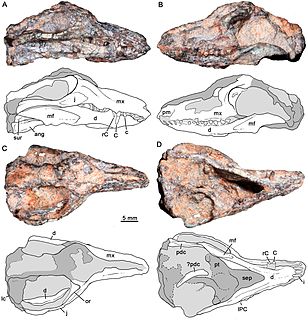
The Accipitridae, one of the three families within the order Accipitriformes, are a family of small to large birds with strongly hooked bills and variable morphology based on diet. They feed on a range of prey items from insects to medium-sized mammals, with a number feeding on carrion and a few feeding on fruit. The Accipitridae have a cosmopolitan distribution, being found on all the world's continents and a number of oceanic island groups. Some species are migratory.

Vulpes is a genus of the sub-family Caninae. The members of this genus are colloquially referred to as true foxes, meaning they form a proper clade. The word "fox" occurs in the common names of species. True foxes are distinguished from members of the genus Canis, such as domesticated dogs, wolves, jackals and coyotes, by their smaller size (5–11 kg), longer, bushier tail, and flatter skull. They have black, triangular markings between their eyes and nose, and the tip of their tail is often a different color from the rest of their pelt. The typical lifespan for this genus is between two and four years, but can reach up to a decade.

Glyphis is a genus in the family Carcharhinidae, commonly known as the river sharks. This genus was thought to contain five different species, but recent studies on molecular data revealed that the species Glyphis gangeticus has an irregular distribution in the Indo-West Pacific region. This genus contains only four extant species. Further species could easily remain undiscovered, due to the secretive habits of Glyphis sharks. Their precise geographic range is uncertain, but the known species are documented in parts of South Asia, Southeast Asia, New Guinea, and Australia. Of the four currently described species, the Ganges shark is restricted to freshwater, while the northern river shark and the speartooth shark are found in coastal marine waters, as well. While the bull shark is sometimes called both the river shark and the Ganges shark, it should not be confused with the river sharks of the genus Glyphis.
In the theory of algebraic curves, Brill–Noether theory, introduced by Alexander von Brill and Max Noether (1874), is the study of special divisors, certain divisors on a curve C that determine more compatible functions than would be predicted. In classical language, special divisors move on the curve in a "larger than expected" linear system of divisors.

The Tibetan fox, also known as Tibetan sand fox, is a species of true fox endemic to the high Tibetan Plateau, Ladakh plateau, Nepal, China, Sikkim, and Bhutan, up to elevations of about 5,300 m (17,400 ft). It is listed as Least Concern in the IUCN Red List, on account of its widespread range in the Tibetan Plateau's steppes and semi-deserts.

Carcharhinus is the type genus of the family Carcharhinidae, the requiem sharks. One of 12 genera in its family, it contains over half of the species therein. It contains 35 extant and eight extinct species to date, with likely more species yet to be described.
In algebraic geometry, a moduli space of (algebraic) curves is a geometric space whose points represent isomorphism classes of algebraic curves. It is thus a special case of a moduli space. Depending on the restrictions applied to the classes of algebraic curves considered, the corresponding moduli problem and the moduli space is different. One also distinguishes between fine and coarse moduli spaces for the same moduli problem.
Mesadactylus is an extinct genus of pterosaur from the Kimmeridgian-Tithonian-age Upper Jurassic Morrison Formation of Colorado, United States. The genus was named in 1989 by James Jensen and Kevin Padian. The type species is Mesadactylus ornithosphyos.

Pelargopsis is a genus of tree kingfishers that are resident in tropical south Asia from India and Sri Lanka to Indonesia.
Kepodactylus is an extinct genus of ctenochasmatid pterodactyloid pterosaur from the Kimmeridgian-Tithonian-age Upper Jurassic Morrison Formation of Colorado, United States.
Tanyuromys aphrastus, known as the long-tailed sigmodontomys, Harris's rice water rat, or the long-tailed rice rat, is a species of rodent in the family Cricetidae. It is known from Costa Rica, Panama, and Ecuador. In 2012, it was reassigned to its current genus from Sigmodontomys.

Alcedo is a genus of birds in the kingfisher subfamily Alcedininae. The genus was introduced by Carl Linnaeus in 1758 in the 10th edition of his Systema Naturae. The type species is the common kingfisher. Alcedo is the Latin for "kingfisher".
Thomandersia is the sole genus in the Thomandersiaceae, an African family of flowering plants. Thomandersia is a genus of shrubs and small trees, with six species native to Central and West Africa.

The Lecanoraceae are a family of lichenized fungi in the order Lecanorales. Species of this family have a widespread distribution.
In classical algebraic geometry, the genus–degree formula relates the degree d of an irreducible plane curve with its arithmetic genus g via the formula:

Protheriodon is an extinct genus of probainognathian cynodonts which existed in the Santa Maria Formation of the Paraná Basin in southeastern Brazil during the middle Triassic period. It contains the species Protheriodon estudianti. It was first described by Argentine palaeontologist José Bonaparte, who assigned it to the family Brasilodontidae. More recent studies have however recovered it in a more basal position than other brasilodontids, just outside Prozostrodontia.
Rewaconodon is an extinct genus of dromatheriid cynodonts which existed in India during the upper Triassic period. It is known from two species: R. tikiensis and R. indicus, both of which were found in the Tiki Formation. Other, undescribed species may have lived in North America.

Carex subg. Carex is a subgenus of the sedge genus Carex. It is the largest of the four traditionally recognised subgenera, containing around 1400 of the 2000 species in the genus. Its members are characterised by the presence of one or more exclusively male (staminate) terminal spikes, quite dissimilar in appearance from the lateral female (pistillate) spikes below. In most species, the female flowers have three stigmas, but a few species, including Carex nigra, have female flowers with only two stigmas.
Ozarkodina is an extinct genus of conodonts in the family Spathognathodontidae.










